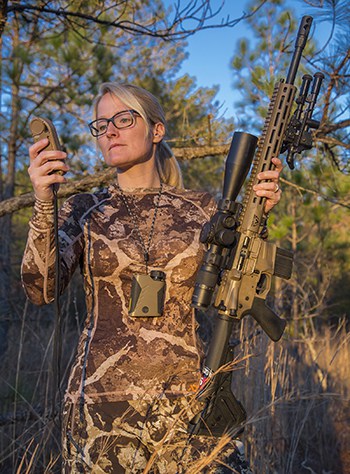Ballistic Calculators and Hunting
By Candice Horner
Candice Horner is a decorated professional shooter with an extensive track record of top finishes at national long-range and multi-gun matches.

image: calculating ballistics
When preparing for a destination hunt, most hunters go through their gear list to ensure they are ready for whatever Mother Nature throws at them. But one of the most overlooked aspects of hunt preparation is making sure you have reliable ballistic data that can be used in any environment. Using a ballistic calculator will help you hit your target, even when the weather differs from where you originally zeroed your rifle.
Ballistic calculators have been around for a long time and can be used by anyone with a basic knowledge of firearms. Essentially, the calculator does a series of complex math problems to instantaneously tell you what your hold is at a given distance. Some ballistic calculator applications, such as Shooter, Strelok, Ballistic, and ABMobile, can be downloaded to your phone. These apps import all your environmental data, provide a bullet database so you don’t have to research your projectile, and allow for quick and simple displays of that information. One of the most important aspects of the apps is the ability to update your ballistic data for the given environment, since the density of the air will affect the bullet’s drop.
SETTING UP YOUR GUN IN THE APP IS EASY.
You just enter a few easy-to-find numbers:
MUZZLE VELOCITY (MV)
The most accurate way to find this is to use a chronograph. If you don’t have access to one, the information on the side of the box is close enough in most situations.
SCOPE HEIGHT (SIGHT HEIGHT, BORE HEIGHT, SH, BH)
Measure from the center of the bore to the center of the scope with any household tape measure. The more accurate the measurement, the better.
ZERO RANGE (ZR)
The distance you zeroed at (usually 100 yards).
BALLISTIC COEFFICIENT (BC)
The BC of the bullet is almost always supplied by the manufacturer and is easy to find with a quick Google search. It doesn’t matter if you use the G1 or the G7 number; just make sure the app is set to whichever one you find. Most popular bullets are housed in the bullet library in the apps, so you just have to select the projectile from the list, and the app will fill everything in.

Remember that the data going out is only as good as the data going in, so make sure your BC, MV, ZR, andSH are accurate. There are many other input areas in the apps, including twist rate, twist direction, and the bullet dimensions. Those factors being slightly off will not make a noticeable difference, so if you don’t know or can’t find that information online, just input a commonsense guess.
After you have zeroed your rifle and set up your gun in the ballistic calculator, the next step is confirming your long-range Data On Previous Engagement (DOPE). Confirming your DOPE ensures the ballistic calculator is showing data that is true to how your rifle is shooting in real life. Confirm your DOPE by shooting a target at the farthest range you plan to shoot an animal as well as at an intermediate distance between your zero distance and the farthest distance. Use the elevation hold shown on your ballistic app for the farthest distance and confirm that your elevation turret matches what the app says when you hit that target.
If the elevation turret doesn’t match, adjust the MV up or down (in the app) until both the turret and app match for the elevation. It’s not uncommon to have to tweak the MV number in the ballistic calculator to match what elevation the round impacts at a specific distance, in real life. But you should only have to adjust the MV to match for the farthest distance in the ballistic app to get it to mirror what the bullet drop is in real life along the whole path of the bullet’s trajectory.
When you get to your hunt location, update the environmental data in the app. In an ideal scenario, you would again confirm your long-range DOPE. Realistically, it’s rare you can confirm more than your zero. If that’s the case, don’t worry. Just check your zero and update the app for the location’s weather. After you have the new elevation holds for the location, create a DOPE card and tape it to the buttstock of your rifle, so don’t have to pull out your phone for reference. With your ballistic calculator set up and your DOPE confirmed, you can go into the backcountry and confidently take that critical shot.








